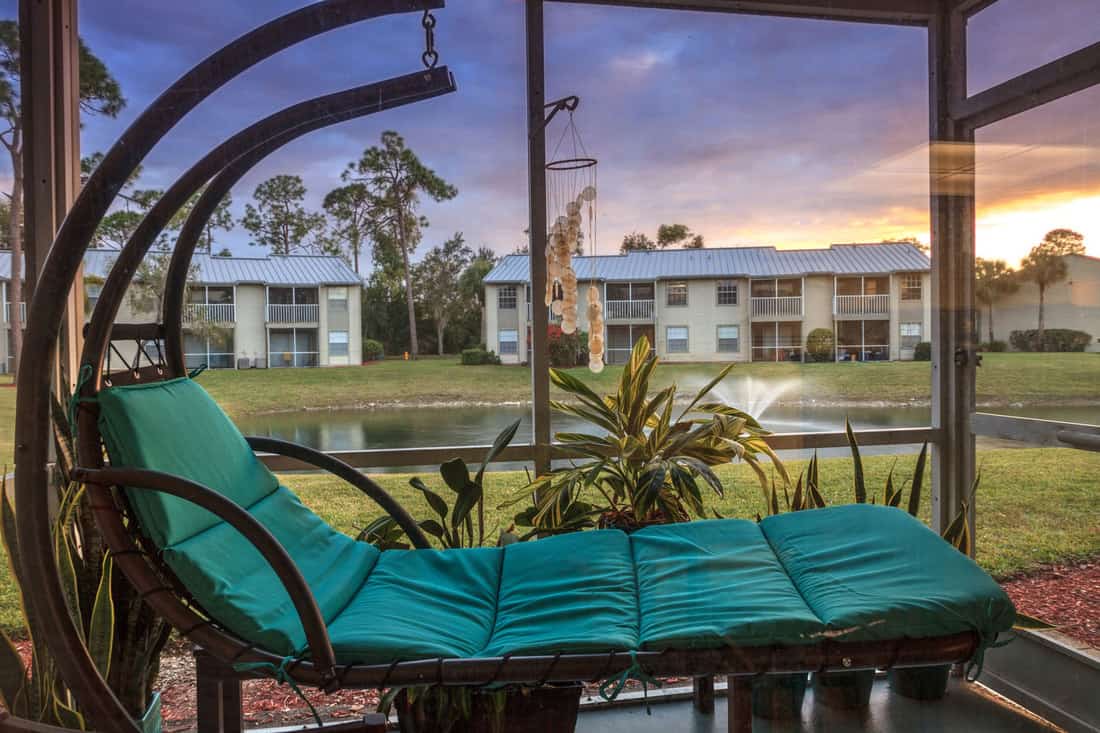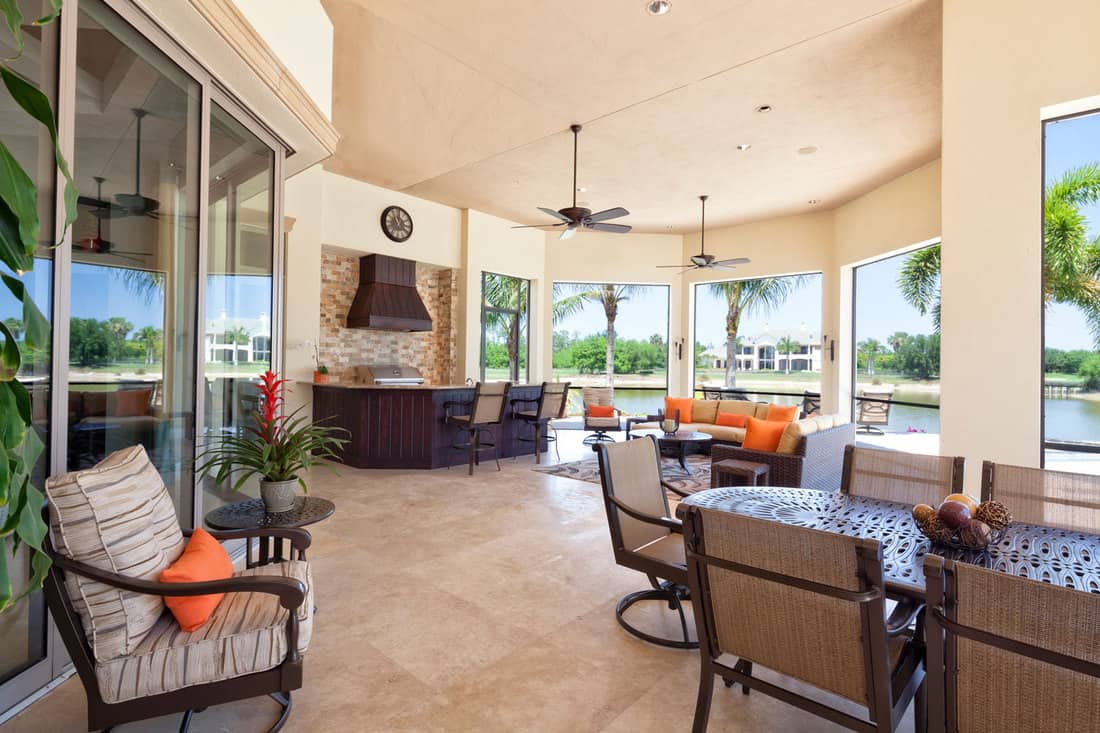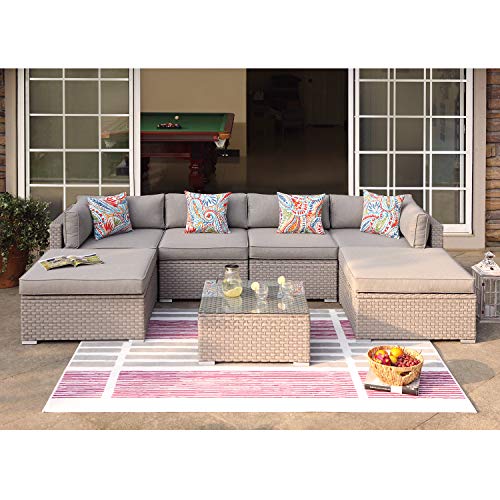Screened and paneled lanais offer several great benefits. Screened lanais keep pesky bugs like mosquitoes and flies away during the warmer months. Paneled lanais help regulate the temperature, which lets people sit outdoors during the colder months. Though lanais can deter pests and regulate temperature, can they block the sun? We've researched this topic thoroughly and have some important information for you.
A lanai's ability to block the sun depends on the material that encloses it. Most screened lanais and paneled lanais block some sun, but they still let some sunlight through them. However, enclosure screens like PVC-coated polyester fabric and solar screens block a good amount of sun.
Now you know that a lanai's sun blockage depends largely on the material that it's made out of, but there is still much to learn about lanais. For example, what do people use lanais for? Can you get sunburned through a lanai? Keep reading to learn more about lanais.
![Outdoor dining room, bar and swimming pool all under a lanai screen, Does A Lanai Block The Sun? [Including UV Rays]](https://homedecorbliss.com/wp-content/uploads/2021/07/Does-A-Lanai-Block-The-Sun-Including-UV-Rays.png)
For What Is A Lanai Used?
We sometimes add affiliate links and content that was curated and created by our team with the help of advanced ai tools to help showcase the best design styles.

People use lanais as extensions of their houses. Due to a lanai being enclosed, homeowners typically decorate it with casual furniture. Because people usually furnish their lanais with casual benches, chairs, and tables, they can use this space as a comfortable extension of their homes.
Click here to find furniture suited for a lanai on Amazon.
Many people use lanais as house extensions year-round. A lanai protects people from the weather and regulates temperature. One way that people put their lanais to use is by eating lunch or dinner on them. People usually choose to eat on the lanai because it's a space where they can enjoy their meal and nature without feeling the effects of the weather.
People also install pools in their lanais. Its enclosure allows people to enjoy nature while also protecting them from bugs and varying degrees of UV rays.
In addition, some homeowners use their lanais for container gardening. Container gardening, or pot gardening, involves growing plants in containers instead of the ground. The lanai enclosure allows sunlight to reach the plants, which they need in order to grow. Also, container gardens are nice simply because they add more beauty to a lanai.
What Materials are Lanais?
As mentioned before, two of the most common lanai materials are screens and panels.
Screened Lanais
![Outdoor dining room, bar and swimming pool all under a lanai screen, Does A Lanai Block The Sun? [Including UV Rays]](https://homedecorbliss.com/wp-content/uploads/2021/07/Outdoor-dining-room-bar-and-swimming-pool-all-under-a-lanai-screen.jpg)
Screened lanais are made out of a variety of materials, including fiberglass, aluminum, and bronze.
Fiberglass is the most popular and inexpensive screen option. Because of this, many homeowners choose fiberglass for their lanai screens. However, even though fiberglass is an inexpensive material, it lacks the durability that other materials have.
If you want a more durable screen material, aluminum is a good option. Aluminum costs a bit more than fiberglass does, but it withstands harsh weather better and longer than fiberglass. In addition, bronze lanai screens cost even more than aluminum lanai screens, but they are even more durable.
Many companies, such as Fabri Tech based in Fort Myers, Florida, offer free consultations to get you started on your journey in picking the right features for your lanai.
Paneled Lanais

Paneled lanais generally cost more than screened lanais because they are made out of glass. A paneled lanai's durability depends on the type of glass it's made from. Hurricane-proof glass provides even more protection than lanai screens do. However, glass that is not hurricane proof offers less protection than lanai screens do. So, if you want a paneled lanai instead of a screened lanai, make sure that you're installing hurricane-proof glass.
Companies such as Lifetime Enclosures in Jacksonville, Florida, specialize in lanai conversions. For a paneled lanai, you can choose from different types of windows and glass for the ultimate customization.
Do Screened and Paneled Lanais Provide UV Protection?
As mentioned before, lanai screens and panels do provide some UV protection. However, both of these enclosure materials still allow some sunlight to shine through them, exposing people to some UV rays. Screened and paneled lanais block anywhere from 30 to 80 percent of sunlight.
Some of the most effective sun-blocking materials include PVC-coated polyester fabric and solar screens. These two enclosure materials block more sun and UV rays than fiberglass, aluminum, bronze, and glass. They also eliminate about 90 percent of the sun's heat. This helps keep your lanai area cooler during the warmer months.
How Do You Block Sun Rays in a Lanai?
The best way to block sun rays in a lanai is to enclose it in PVC-coated polyester fabric or a solar screen. There are many different solar screens that you could use for enclosing your lanai.
One good solar screen option for your lanai is the 65 percent solar insect screen. This solar screen does more than just protect you from harmful UV rays. The tiny mesh that forms this screen ensures that even the smallest bugs cannot enter your lanai. So, if bugs are a big nuisance in your area, this may be the perfect solar screen for your lanai.
Another potential solar screen for your lanai is the 90-95 percent textilene / suntex screen. As the name of the screen implies, this screen is made from textiline and suntex. Textiline is made of tightly woven polyester and is very durable. Suntex is made of the same material that textiline is made of, but it includes additives that make it resistant to bacteria and fungi. Solar screens made from textilene and suntex can last more than 10 years. Additionally, they are pet and hail resistant.
You could also install a motorized screen for your lanai. Motorized lanai screens are typically made out of fabric and mesh, which typically last about 10 years. Motorized lanai screens are very beneficial because you can control them with the simple touch of a button.
If you want to install any type of solar screen, expect to pay about $300 per window. However, the cost will vary based on the type of material that forms your solar screen.
Can You Get Sunburned Through a Lanai?
You can definitely get sunburned through a lanai. We've already established that lanai enclosures do not block all sun and UV rays. The UV rays that pass through lanai enclosures burn people.
To prevent sunburn, apply sunscreen before entering your lanai. This is especially true if you're swimming.
In Closing
Lanais make great extensions of the home in tropical climates. People use their lanais in so many different ways; they eat in them, install pools in them, and start container gardens in them. Overall, lanais provide a variety of ways for people to connect with the outdoors while bringing some comfort from the indoors.
However, it's important to remember that lanais don't block all sunlight. Therefore, you can get burned through one. Be sure to apply sunscreen before using your lanai so that you don't get burned!
Before you go, check out some of our other articles that may be of interest to you:
Are Pool Enclosures Required in Florida? [A Thorough Look Into the Requirements]

